Defra’s 2025 UK bird data: Three species which are declining – and three that could be making a comeback
By Amber Allott
Copyright northernirelandworld

New UK bird population data shows that a worrying decline in recent years has sped up latelySome species are still doing well, increasing in numbers even as the environment changesOthers, including much-loved birds like the turtle dove, are still in serious troubleBut conservation work appears to be paying off for some highly threatened species over the last few years
Some everyday birds commonly spotted in parks, woodlands and duckponds have had a rough couple of years, new data suggests.
The Department for Environment, Food & Rural Affairs (Defra) has this week released its latest wild bird population statistics, which show how woodland, farmland, water and wetland species across the UK were faring as of 2024. Since 1970, bird populations have dropped by almost one fifth across the country, and unfortunately, last year saw that trend continue.
The latest figures show that the overall species index – a figure used to help measure the abundance of more than 130 birds – has fallen by about 4% UK-wide in the five years since 2019, representing a slightly more accelerated drop than in the earlier 2000s. But when it comes to different habitats or individual species, how populations are doing are a bit more of a mixed bag, with some good news in there too.
So which beloved local birds have seen their numbers start to bounce back a little in recent years, and which are still in decline – or have suddenly found themselves in freefall? Here are a few key species which have experienced surprising changes over the last few years, as well as why Defra says their populations might be trending up or down:
Birds which are doing a little better
1. Chiffchaff
These tiny woodland warblers, a common sight in lowland woods and parks across all four UK countries, are doing especially well, with their populations almost doubling since 1970. In recent years, this has only sped up – with chiffchaff numbers shooting up another 37% since 2018.
Chiffchaffs aren’t the only woodland specialists doing well either, with nuthatch numbers trebling, and both blackcaps and great spotted woodpeckers more than quadrupling since 1970.
Defra says their success shows just how differently changes to our environment can impact different species. It lists milder winters in recent years as potentially having a beneficial impact for some birds, as well as recent increases in tree cover.
2. Corn bunting
These stocky little farmland birds, most often found in England and a few parts of Scotland, have been in trouble for some time. Overall, their numbers have fallen more than 80% on 1970 levels. But over the last five years, there are signs their fortunes may be changing. Defra says their population has increased by about 17% since 2018.
The report shows a few other species that frequent our fields and farms are doing well too. Stock dove and goldfinch numbers have more than doubled since 1970, with stock doves in particular continuing to climb by about 18% in the most recent five years.
More environmentally friendly farming practices in recent years might be playing a part. “Most farmers can and do take positive steps to conserve birds on their land”, Defra says, with incentive schemes encouraging things like leaving uncropped margins around crop fields, and planting bird-friendly cover plants over winter to provide much-needed seeds.
3. Little egret
These dainty white herons, which can be found in coastal areas across the country, have been generally increasing in numbers over the long term. But over the short term, their population has climbed by about 19%.
Other wetland and waterbird species that seem to be doing well include teal, and tiny reedbed residents Cetti’s warblers – with the population undergoing a 10-fold increase since just 1988.
Defra says that a range of these species have benefited from new pond and lake habitats being created in recent years, especially in restored gravel pits. Additionally, milder winters in recent years have improved survival rates for youngsters.
Birds which are worse off
1. Green woodpecker
This woodland native – our largest woodpecker – is considered to be in the green category when it comes to conservation. It remains widespread across most of England and Wales, as well as eastern Scotland. But while its numbers generally show little change over the long term, they have suddenly and rapidly declined in the short term – a whopping 22% since 2018.
In England, similar recent dips can be seen in garden warbler and coal tit populations, Defra says. Across the UK as a whole, the figures showed three woodland species in serious trouble, with their numbers declined by over 90% since 1970. These were the willow tit, capercaillie, and spotted flycatcher.
General reasons for woodland bird numbers falling listed in the report include lack of woodland management and competition with deer, while outside of their traditional homes they are threatened by disappearing hedgerows, as well as habitat deterioration, non-native and feral predators, and disease in urban environments.
These glamorous plovers could once be spotted nesting in fields almost anywhere in the UK. But they’ve fallen in numbers by more than 65% since the 1970s, with the last few years showing no turnaround – and an even stronger rate of decline.
Other farmland birds which have seen huge drops since 1970 include turtle doves, tree sparrows, grey partridges, and starlings. Turtle doves especially have continued to decline in the short term, the report says. Greenfinches and kestrels are both seeing long term declines too, while reed buntings have experienced a sharp and sudden fall in just the last few years.
Defra’s report says that changes in farming practices since the 1950s and 60s may be playing a part. This includes hedgerows being removed, less mixed farming, and increased pesticide and fertiliser use, which meant nesting sites and food sources were lost – although as mentioned above, this is now changing on many farms.
3. Great Crested Grebe
These spectacularly-ruffed birds can be found dotted across lakes and ponds in parts of all four UK countries. They’re of low conservation concern, according to the RSPB, but Defra’s figures show an alarming drop. Over the long term, numbers of great crested grebe have decreased by 33% in the UK, with a continued, strong decline over the most recent five-year period too.
But again, grebes aren’t the only wetland or waterbirds with falling numbers. Redshanks, snipes, and yellow wagtails have all seen lengthy stretches of decline – especially wagtails, which have lost more than 95% of their population. This has stabilised a little in recent years, unlike the humble mallard duck and once-common coot, which have only recently started to dwindle.
Historically, Defra says that land management changes like drainage and converting coastal and floodplain marshes into farmland have caused issues. But even in the “small fragments of high-quality habitat” where populations persist, their nests and young are vulnerable to predators – “which is currently thought to be limiting the recovery of several species of breeding wader”.
Want to learn how to help nature at home or in your garden? Here are four flowers in bloom right now you can plant to give wildlife a helping hand – and here’s everything you need to know about the September ‘super food’ to add to your bird feeder.



